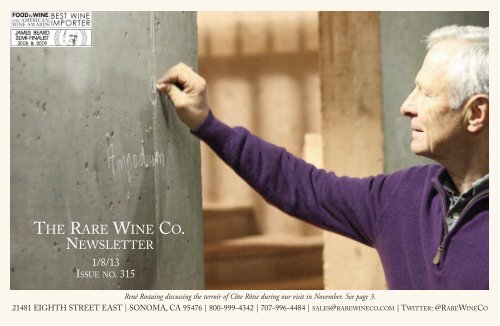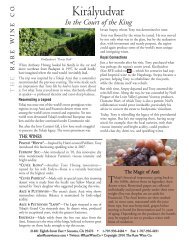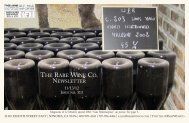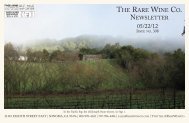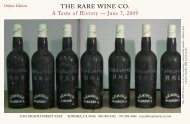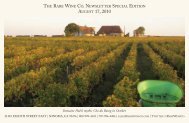Create successful ePaper yourself
Turn your PDF publications into a flip-book with our unique Google optimized e-Paper software.
<strong>THE</strong> <strong>RARE</strong> <strong>WINE</strong> <strong>CO</strong>.<br />
NEWSLETTER<br />
1/8/13<br />
ISSUE NO. 315<br />
René Rostaing discussing the terroir of Côte Rôtie during our visit in November. See page 3.<br />
21481 EIGHTH STREET EAST | SONOMA, CA 95476 | 800-999-4342 | 707-996-4484 | SALES@<strong>RARE</strong><strong>WINE</strong><strong>CO</strong>.<strong>CO</strong>M | TWITTER: @<strong>RARE</strong><strong>WINE</strong><strong>CO</strong>
<strong>THE</strong> <strong>RARE</strong> <strong>WINE</strong> <strong>CO</strong>.<br />
21481 EIGHTH STREET EAST SONOMA, CA 95476 800-999-4342/707-996-4484 email us at sales@rarewineco.com<br />
J a n u a r y 8 , 2 0 1 3 - O N LI N E ED I T I O N<br />
Schrader<br />
“There doesn’t appear to be a hotter Cabernet<br />
Sauvignon producer in the New World.” Parker<br />
Fueled by seven 100-point ratings from Robert Parker, Fred Schrader’s<br />
Cabernets are arguably the most intensely collected new California Cult<br />
Cabernets of the past decade. And they could also be the best.<br />
With the brilliant Thomas Brown as his winemaker, Fred Schrader has taken<br />
the uniquely compelling approach of making multiple Cabernets, of which four<br />
in 2010 are from the same vineyard—Oakville’s venerated To Kalon, owned by<br />
Andy Beckstoffer.<br />
The difference in the four To Kalon cuvées is that each is from a different To<br />
Kalon parcel and from varying Cabernet clones: Old Sparky from Clones 4, 6 and<br />
337; CCS all from Clone 4; T6 all from Clone 6; and RBS all from Clone 337.<br />
The fifth wine, George III, is its own terroir expression—from an extraordinary<br />
site in nearby Rutherford that boasts very different soils from To Kalon.<br />
Collectively, the strikingly diverse To Kalon cuvées are about as a clear a lesson as<br />
you’ll find in the influence of clones. And of course George III, which shares<br />
the same clone as RBS, underscores the importance of soil.<br />
Been There Before<br />
Fred Schrader is not new to being a cult star, having been co-producer of the<br />
legendary Colgin-Schrader Cabs of the early '90s.<br />
And for his second ride to the top, he couldn’t have picked a better winemaker<br />
than Thomas Brown, whose natural winemaking is ideally suited to the To Kalon<br />
fruit—as well as to Schrader’s predisposition to purity.<br />
Antonio Galloni is now reviewing the Schrader wines for Parker, having cut his<br />
teeth on the 2009s. He shares Parker’s enthusiasm for Schrader’s Cabernets; and the<br />
secondary market for the wines hasn’t skipped a beat, with prices continuing to rise.<br />
2010 Cabernet RBS<br />
97 Galloni<br />
$295.00<br />
2010 Cabernet Old Sparky<br />
98 Galloni<br />
$750.00 magnum<br />
2010 Cabernet CCS<br />
97 Galloni<br />
$295.00<br />
2010 Cabernet George III<br />
96 Galloni<br />
$275.00<br />
2010 Cabernet T6<br />
96+ Galloni<br />
$295.00
A Stunning Burgundy Value<br />
“…Pavelot is indisputably making the best wines in the village ... they age<br />
extremely well.” Burghound<br />
“…great Savigny wine with Côte de Nuits-like nuance.” Stephen Tanzer<br />
In a world of increasingly expensive Burgundies, knowledgeable connoisseurs<br />
know that fine expressions of Burgundy’s glorious terroirs can be had for very<br />
fair prices ... if you know where to look. One of their favorite hunting<br />
grounds is Savigny-Lès-Beaune.<br />
And in Savigny, the number one address is Domaine Pavelot, where Jean-Marc<br />
Pavelot’s premier cru La Dominode has been a show-stopper in recent years.<br />
In fact, for transparency of expression combined with value, La Dominode is<br />
not only the most exciting wine being made in Savigny today, it rivals<br />
anything made in the entire Côte d’Or.<br />
40 Years in the Making<br />
Ever since Jean-Marc took charge of his family’s two-century-old estate in<br />
Jean-Marc Pavelot’s Savigny 1er Cru La Dominode<br />
Red Burgundy | 2<br />
1969, Pavelot has been producing many of Savigny’s top wines. And since Jean-Marc’s<br />
son Hugues joined him in 1997, the wines are better than ever, boasting both<br />
Savigny’s richly fruited accessibility and uncommon depth and complexity.<br />
While Pavelot’s entire range of six Savigny premier crus has these characteristics<br />
in spades, La Dominode stands apart for its complete expression of one of the<br />
village’s finest sites—a parcel of sandy clay within the excellent Jarrons vineyard,<br />
long recognized as a separate sub-cru for the superiority of its wine.<br />
In the hands of Jean-Marc and Hugues—the remarkable terroir of La Dominode<br />
classically expressed through the fruit of their 80-year-old vines—results in a<br />
finely balanced wine of stunning complexity and aging potential.<br />
Even more remarkable is the price. Pavelot’s Dominode is that rare example of<br />
fine Burgundy that represents great value for what is in the bottle.<br />
There is something right in the world of wine when you can buy true<br />
old-school Burgundy at old-school prices. These are sure to go fast.<br />
2007 Jean-Marc Pavelot Savigny-Lès-Beaune La Dominode*<br />
$39.95 bt. $ 230 six-pack<br />
Burghound: “92 rating … pure and ripe aromas of plum, earth, stone and spice<br />
hints that introduce intensely earthy medium-bodied flavors that are textured<br />
and refined but powerful, all wrapped in a finish that displays a hint of animale<br />
on the structured finish that seems to go on and on.”<br />
2010 Jean-Marc Pavelot Savigny-Lès-Beaune La Dominode*<br />
$44.95 bt. $ 260 six-pack<br />
Burghound: “93 rating. The dense, serious and overtly powerful flavors possess outstanding<br />
concentration and even though the very firm tannins are borderline chewy<br />
there is so much extract that there is a velvety texture to the explosively long, balanced<br />
and harmonious finish ... strikingly impressive and clearly built to age.”<br />
An Earlier Savigny Legend<br />
from Chandon de Briailles<br />
2005 Chandon de Briailles Savigny-Lès-Beaune Les Lavières ....................... 49.95<br />
John Gilman: “... the 2005 at Chandon de Briailles takes this cru to a level of quality that I have not<br />
encountered before. The bouquet is deep, stunning in its purity, and utterly enchanting ... On the palate<br />
the wine is deep, medium-full and creamy on the attack, lovely intensity of flavor and transparency, and<br />
a long, suave finish of bouncy acidity and supple tannins. Just a beautiful bottle of Savigny ...”<br />
TAKE ADVANTAGE of our low-cost Ground Shipping this<br />
fall: $25/case or $15 within California, including free packaging<br />
and free insurance up to $400 per case.
The “democratization” of wine over the past two decades has<br />
raised the quality bar worldwide.<br />
But it has also made it much harder to sort out which producers,<br />
vineyards and wines are the real deal—and which only seem to be so.<br />
Those of us who lust for wines that are not just good, but say<br />
something special, have gravitated towards places like Burgundy,<br />
Piedmont and the Northern Rhône, where we find wines that<br />
speak to us. And in the latter region, there is no more special place than<br />
Côte Rôtie and no more special grower today than René Rostaing.<br />
The beauty of Côte Rôtie stems from its extraordinary terroirs, a series of vertiginous<br />
east- and southeast-facing slopes of varied mineral composition. These terroirs produce<br />
wines of such natural elegance that they are the Burgundies of the Rhône Valley.<br />
Preserving Two Legacies<br />
The magic of René Rostaing lies not only in his wines, but in his role as a steward<br />
of two legendary domaines of the past: Gentaz-Dervieux and Dervieux-<br />
Thaize. But more important, it comes from his singleminded determination<br />
to produce wines that express their Côte Rôtie origins in a pure, natural way.<br />
Poetry in a Bottle<br />
The Profound 2010 Côte Rôties of René Rostaing<br />
Northern Rhône | 3<br />
Rostaing has kept alive the spirit of his mentors, Marius Gentaz<br />
and Albert Dervieux, by a judicious use of whole clusters and by<br />
using relatively little new wood, to express the soil and grape.<br />
He has also steered well clear of the efforts of many of his<br />
neighbors to mimic the power of Hermitage.<br />
Ties to Burgundy<br />
John Livingstone-Learmonth, who has studied Côte Rôtie intimately<br />
for four decades, writes that he expects “greater liaison between Côte-Rôtie and<br />
Burgundy than I do between Côte-Rôtie and Hermitage.” And the term that he<br />
chooses to describe René Rostaing’s wines is Burgundian.<br />
Rostaing, as quoted by Livingstone-Learmonth, calls 2010 a year that “has<br />
everything ... structure, finesse, precision.” As for Livingstone-Learmonth, he<br />
compares the 2010s, first and foremost, to the 1978s, arguably the greatest<br />
Côte Rôtie vintage of our time.<br />
We have been Rostaing’s U.S. importer for the past decade, and we believe<br />
his 2010s to be among the finest expressions of Côte Rôtie that we will see.<br />
If you love wine of profound expression, you will want to have them.<br />
2010 Côte Rôtie Ampodium*<br />
94 Parker<br />
HHHH(H) Livingstone-Learmonth<br />
$72.00 bt. $ 420 six-pack<br />
Rostaing’s “Classique” is now labeled “Ampodium.”<br />
Parker: “From a dozen separate terroirs ... rich and<br />
opulent ... superb.”<br />
Livingstone-Learmonth: “... a lot of fruit with life<br />
and stimulus in it, shows a smoky depth. Captivating<br />
... this is really going to be delicious ... Great pleasure<br />
to come. A wine with flair.”<br />
2010 Côte Rôtie La Landonne*<br />
96 Parker<br />
HHHHHH Livingstone-Learmonth<br />
$139.95 bt. $ 795 six-pack<br />
$295 magnum<br />
Parker: “... prodigious ... a huge, impressive perfume ...<br />
mineral-dominated, well-delineated, rich, intense wine.”<br />
Livingstone-Learmonth: “... perfumed ... like having<br />
leather seats in the car—lovely stuff ... extreme<br />
length and freedom in the wine.”<br />
2010 Côte Rôtie Côte Blonde*<br />
98 Parker<br />
HHHHHH Livingstone-Learmonth<br />
$159.95 bt. $350 magnum<br />
In 2010, tiny “shot” berries reduced Rostaing’s Côte<br />
Blonde output by half, but what remained was glorious.<br />
Parker: “... close to perfection ... beautiful aromas ...<br />
Seductive endlessly constructed texture and huge length.”<br />
Livingstone-Learmonth: “A sensuous promise …<br />
Very long indeed. Outstanding wine.”
Rediscovered<br />
An Historic Tuscan Cabernet Gets Its Due<br />
Tuscany | 4<br />
When Sassicaia came into its own in the 1970s, it spawned<br />
three other important Tuscan Cabernets, each of which<br />
had close ties to Sassicaia and/or its owner Marchese<br />
Incisa della Rocchetta.<br />
One was Solaia, created in 1978 by Incisa's cousin Piero<br />
Antinori, working with Incisa's enologist, Giacomo Tachis.<br />
Another was Ornellaia, first made in 1985 by another Incisa<br />
cousin, Ludovico Antinori.<br />
The third was sandwiched in between: Sammarco, first produced<br />
in 1980. Also the handiwork of Giacomo Tachis, Sammarco was the idea of the<br />
visionary Alceo di Napoli, whose Castello dei Rampolla estate dates to the 1700s.<br />
A Different Trajectory<br />
Of course, Sassicaia, Solaia and Ornellaia have gone up, up and up in<br />
“They have so much character<br />
and complexity, I<br />
have a gut feeling that it<br />
is Sammarco, not<br />
Sassicaia, that should<br />
have a cult following.”<br />
Robert Parker, 1986<br />
fame and price. Meanwhile, Sammarco—absent the glamor of Antinori<br />
or Incisa—has been a somewhat forgotten Super Tuscan, much<br />
admired by insiders, yet largely unknown to the wine-buying public.<br />
But there may be another explanation for Sammarco trailing in<br />
the glamor category: its understated style which reminds many<br />
tasters of a fine red Graves from Bordeaux.<br />
Its unique style is a reflection of an extraordinary terroir: the Conca<br />
d’Oro vineyard with its amphitheatre-like contours and galestro soil.<br />
A New Awakening<br />
But Sammarco's anonymity may be ending, thanks to the recent attention lavished<br />
on the wine by Antonio Galloni. Prices are sure to rise, but for<br />
now it’s possible to buy some of the great vintages of the 2000s at<br />
bargain prices.<br />
2004 Sammarco*<br />
$69.95 bottle<br />
Galloni: “93 rating ... a wonderfully fragrant nose of spices and violets. It is a<br />
rich, powerful effort packed with an array of blueberries, blackberries and<br />
grilled herbs ... This gorgeously pure wine should drink effortlessly to age 25.”<br />
2006 Sammarco*<br />
$59.95 bottle<br />
Galloni: “92 rating ... flows across the palate with waves of beautifully delineated<br />
dark fruit. Grilled herbs, smoke, menthol, licorice and minerals come<br />
to life on the palate, adding further complexity ... a wine built on elegance<br />
and class above all else .... ”<br />
2007 Sammarco<br />
$89.95 bt. $45.00 half bt.<br />
Galloni: “97 rating ... a showstopper. A dazzling bouquet leads to layers of<br />
rich dark fruit in this superb, racy wine. The tannins are all about finesse ...<br />
a wine that impresses for its sexy personality and fabulous overall balance.”<br />
2008 Sammarco*<br />
$109.95 extremely limited<br />
Galloni: “98+ rating... freshly cut flowers, red berries, mint and licorice<br />
burst from the glass ... Dazzling aromatics, beautifully delineated fruit and<br />
fabulous structure ... stunning, breathtaking ... I wish every Wine Advocate<br />
reader could taste this wine.”
A Final Curtain Call<br />
The Last Vintage for Victor Huet’s Prized Haut Lieu Vines<br />
Vouvray | 5<br />
During World War II, Victor Huet, the founder of the revered Domaine<br />
Huet, planted a small section of vines on the best exposed part of Le<br />
Haut-Lieu, the domaine’s heart and soul.<br />
For the next half century, this plot of vines contributed disproportionately to<br />
the greatness of legendary Le Haut-Lieu wines like the 1947, 1959 and 1971<br />
Moelleux. But advancing age slowly reduced the vines’ output until the decision<br />
was made in 1993 to replant them prior to the next growing season.<br />
Given the vines’ importance—both historically and vinously—it was a difficult<br />
decision for Noël Pinguet and his young assistant Jean-Bernard Berthomé. But<br />
the vines’ output was no longer economically viable.<br />
A Last Hurrah<br />
Before the vines could be ripped out, there was one more chance for these heroic<br />
vines to produce greatness: the 1993 vintage. However, hopes dimmed over<br />
the course of the summer, as relatively cool weather led to a slow ripening.<br />
But as sometimes can happen, a period of rain in September led to a daily incidence<br />
of morning fog followed by sunny afternoons and cold nights.<br />
The result: an explosion of botrytis-induced ripeness in this providential part of<br />
Huet’s Fabulous Pétillant<br />
Insiders know this to be not only one of the world’s great sparkling wine values<br />
but a clear rival to any number of more expensive Champagnes. The 2007 is<br />
simply brilliant.<br />
2007 Huet Pétillant Brut ........ $ 26.95 bt. $ 150 6-pack<br />
John Gilman: “92+ rating ... beautifully classic nose ... scents of pears, sweet<br />
quince, chalky soil tones, orange peel, a touch of warm biscuit ... On the<br />
palate the wine is deep, full-bodied, complex and beautifully balanced ...<br />
Le Haut-Lieu. A small amount of very rich Moelleux 1ère Trie was made—a<br />
Last Hurrah for the vines.<br />
A Glorious Sweet Vouvray<br />
Thanks to Pinguet’s and Berthomé’s perfectionist work in both vineyard and<br />
cellar, and reduced yields from the old vines, the 1993 Le Haut-Lieu Moelleux<br />
1ère Trie is extravagant in its honeyed sweetness, concentration and texture.<br />
Yet its richness is more than offset by the brilliant acidity of a cool summer.<br />
This structure gives laser-like focus and precision to the wine, while amplifying<br />
its minerality and sense of terroir.<br />
Huet’s Private Stock<br />
Given the '93’s symbolic importance—the domaine chose to hold on to a single<br />
bin which they never sold. But as the wine neared its 20th anniversary—about<br />
to enter its prime—they allowed us to purchase most of the remaining bottles.<br />
Needless to say, this is the kind of provenance of which dreams are made; these<br />
treasures have slumbered undisturbed since birth in Huet’s frigid, humid chalk<br />
cellars until direct delivery to us this fall, as the domaine’s U.S. importer.<br />
This level of Vouvray becomes its most expressive around the 20-year mark and will<br />
continue to evolve for another 10 to 20. With only a few hundred bottles remaining in<br />
the world, this is likely to be your only chance to experience this unique and great wine.<br />
1993 Huet Le Haut-Lieu<br />
Moelleux 1ère Trie<br />
$64.50 bt. $ 360 6-pack<br />
Chris Kissack, who writes very knowledgeably under his British blog name,<br />
Wine Doctor, lavished praise on the wine: “A very rich colour for the Loire. The<br />
nose has honeycomb, smoke, butter, bay, and stony minerals. On the palate there<br />
are piles of fresh acidity carrying forth a raft of intense, minerally, slightly honeyed<br />
fruit with notes of bottle age. Lovely intensity and acidity. This is brilliant.
Cockburn’s Stars<br />
Pristine Bottles of the Legendary 1963 & 1983<br />
Vintage Port | 6<br />
Cockburn, Smithes & Co. was founded in 1815, when Robert<br />
Cockburn settled in Oporto after serving with the Duke of<br />
Wellington in the Peninsula Wars. For much of its 197 years<br />
of existence, Cockburn has enjoyed a loyal following for its rich,<br />
meaty, often chocolatey Vintage Ports.<br />
Yet, its fame has ebbed and flowed over time. Its glory days came<br />
in the first three decades of the 20th century, with monumental<br />
wines in 1900, 1908 and 1927. It again came on strong with a brilliant<br />
1955 and 1963, only to fall off a second time when it failed to<br />
declare the great 1977 vintage.<br />
But in 1983, with its reputation on the line, Cockburn made arguably<br />
the wine of the vintage, sacrificing output to be sure its Vintage Port was without rival.<br />
Our bottles from a UK country house<br />
Thanks to its small production, 1983 Cockburn is rarely seen in the<br />
market. Yet, a couple months ago, we bought a beautiful parcel in the<br />
UK that had been in the same cellar for nearly three decades. That wine<br />
has now arrived in Sonoma.<br />
More recently, we discovered a few cases of Cockburn’s great 1963<br />
Vintage Port, stored in the same country house cellar its entire life. Best<br />
of all, it’s Oporto-bottled, a rarity in this great vintage. We’ve bought a<br />
number of ports from this particular cellar, and they’ve been some of the<br />
most perfect bottles we’ve seen in years.<br />
Of course, 1963s and 1983s will be particularly desireable this year, and<br />
these two examples are highly recommended for birthdays and anniversaries.<br />
1983 Cockburn Vintage Port*(Oporto-Bottled)<br />
97 Suckling 95 Parker 95 Hersh<br />
$110.00<br />
James Suckling: “... a great young vintage Port ....”<br />
Robert Parker: “... the massive blockbuster of the tasting was the 1983 ...”<br />
Roy Hersh: “... a big wine ... offers up currants, walnuts and toffee with mocha<br />
prevalent on the mind-blowing aftertaste.”<br />
From<br />
the Same<br />
Country<br />
House<br />
Left & Center: 1945 Sandeman capsules and labels. Right: The 1963 Taylor.<br />
1963 Cockburn Vintage Port* (Oporto-Bottled)<br />
HHHH Mayson 94 Roy Hersh<br />
$195.00<br />
Roy Hersh: ”Full, chewy and very smooth ... a classic and beautifully made 1963 ...”<br />
Richard Mayson: “... liqueur cherry character, rich and focused, still powerful<br />
with ripe tannins showing through, lovely length, combining power and finesse<br />
in equal measure.”<br />
The '63 Cockburn above is not just from any UK country house cellar ... it’s from<br />
one of the all-time greats. It represents a combination of superior conditions<br />
and an obsessive owner.<br />
As if the ‘63 Cockburns aren’t spectacular enough, we also purchased some 1945<br />
Sandeman whose condition surpasses any '45s we’ve seen in at least a decade. And we<br />
can offer, from the same cellar, some beautiful 1963 Taylor, bottled by Grants of St.<br />
James, one of the best London bottlers of that era. The photos speak for themselves.<br />
1945 Sandeman Oporto-Bottled* ....................................................995.00<br />
1963 Taylor Grants of St. James-Bottled* .........................................295.00
Like Jean-Marc Roulot at virtually the same time,<br />
Bernard Billaud returned to his family’s domaine in<br />
1991 after years of pursuing a career in the arts. And<br />
just as Jean-Marc’s did for Domaine Roulot, Bernard’s<br />
return marked a new beginning for Billaud-Simon.<br />
Bernard is quoted as saying: “The estate made good wine beforehand, but it lacked<br />
class, it was not sufficiently ethereal and delicate. It was also my father’s wish to improve<br />
the quality, but he did not have the technology. I finally decided to start afresh.”<br />
He had plenty to work with, inheriting a domaine founded in 1815 and boasting<br />
vines in four of the seven grand cru Chablis vineyards, along with five premier<br />
crus. Only William Fèvre has such impressive holdings.<br />
To extract the most purity and expression from his vines, Bernard<br />
moved to a largely no-wood approach, featuring fermentation at very<br />
cold temperatures and extended lees contact. He believes that without<br />
cold fermentation temperatures, Chablis’ primary aromas<br />
become burned and Chablis loses both its complexity and its finesse.<br />
Billaud-Simon<br />
Amazing 2010 Chablis from a Mythic Domaine<br />
Billaud’s 65-year-old Blanchot vines abut Les Clos at left.<br />
White Burgundy | 7<br />
But while most of the domaine’s wines see no wood, Bernard<br />
intelligently ages a couple of his greatest old-vine cuvées in<br />
barrel. This includes the remarkable Blanchots Vieilles Vignes,<br />
from a parcel of 65-year-old vines abutting Les Clos.<br />
Allen Meadows says that Bernard believes that Blanchot is<br />
“the most mineral-dominated cru in Chablis, indeed so much so that it can be a<br />
brutal and violent wine that must be tamed by the wood.”<br />
The Great 2010s<br />
Two thousand ten is one of the those great Chablis vintages that comes along rarely.<br />
Meadows quotes Bernard Billaud as calling it “a complete classic. If the wine school textbooks<br />
had a description of what a classic Chablis is supposed to smell and taste<br />
like, then 2010 produced it. The wines are exceptionally mineral-driven.”<br />
Billaud-Simon’s wines have superb richness and character, with the<br />
capacity for years of aging. We are proud to offer three “don’t miss”<br />
Billaud-Simon 2010’s at very attractive prices.<br />
2010 Chablis Grand Cru Les Preuses*<br />
$79.95 bottle<br />
Burghound: “96 rating. This sports a classic Chablis<br />
nose with plenty of oyster shell and iodine nuances<br />
to the elegant and very pure green fruit, floral and<br />
citrus aromas. There is a highly attractive texture to<br />
the silky mouth feel ... more about harmony and<br />
finesse than power ... hugely lingering finish. An<br />
absolute stunner of a Preuses that should age beautifully<br />
and one of the wines of the 2010 vintage.”<br />
2010 Chablis 1er Cru<br />
Montée de Tonnerre<br />
$45.00 bt. $23.95 half bt.<br />
Burghound: “94 rating.. A reserved yet classic Chablis<br />
nose that is ultra-fresh, pure and elegant with the<br />
hallmark floral and stone notes ... rich, dense and<br />
impressively well-detailed flavors that culminate in a<br />
mineral-inflected and driving finish. A wine of harmony<br />
and balance that should age well plus it offers<br />
so much Chablis character that this would be almost<br />
impossible to miss blind. In sum, one to buy.”<br />
2010 Chablis Grand Cru Blanchots<br />
“Vieilles Vignes”*<br />
$95.00 very limited<br />
Burghound: “96 rating. ... floral, citrus and almost<br />
pungently mineral and iodine-inflected nose ... fresh,<br />
pure and refined flavors that possess exceptionally fine<br />
detail as well as excellent mid-palate concentration ...<br />
explosive ... endless reserves of mouth coating extract.<br />
Impressive in every respect; indeed this is a wow wine.”
Rare Bird<br />
Jean Foillard’s Impossible-to-Find 2009 Cuvée 3.14<br />
Beaujolais | 8<br />
The great vignerons of France sometimes like to toy<br />
with us. They make enough wine in total to both satisfy<br />
the market and secure their reputations. But then<br />
they make something really special ... and really rare.<br />
Thus, Chave has its Cuvée Cathelin, Coche-Dury its Corton<br />
Charlemagne and Freddie Mugnier his Musigny. But good<br />
luck ever finding a bottle—or if you do, paying less than<br />
four figures for the privilege of owning it.<br />
Beaujolais’ Ultimate Rarity<br />
The Beaujolais icon Jean Foillard also likes to play with us.<br />
In addition to his famed Morgon Côte du Py, he makes a<br />
miniscule amount of Cuvée 3.14, a wine that—while potentially<br />
Beaujolais’ most compelling wine—is almost impossible<br />
to find.<br />
You would be hard-pressed to find even six bottles of 3.14 in a<br />
Paris cave, despite the fact that Foillard’s Morgons grace the lists of<br />
most Michelin 3-star restaurants. The reason is simple: he allocates<br />
only a few bottles to each account, regardless of their stature.<br />
But we love a challenge. Having tasted the mindblowing 2009 Cuvée 3.14 early<br />
on, we’ve been on a mission to accumulate enough for an offer that’s unique in<br />
the U.S. market. And so we did.<br />
Ancient Vines<br />
In charge of his family’s domaine since 1980, Foillard is a follower of the teachings<br />
of the great Jules Chauvet, the father of France’s natural wine movement.<br />
He tends his ancient vines organically, makes and ages his wine traditionally and<br />
doesn’t chaptalize, filter or sulfur his wine.<br />
His Morgon Côte du Py has long been revered as one of Beaujolais’ greatest<br />
wines. The 3.14 (the number for “Pi”) is greater still, with an unending complexity<br />
that must be the source for the wine’s name—beyond the obvious wordplay.<br />
Gamay Heights<br />
This towering wine results from the region’s greatest producer seizing on the<br />
monumental 2009 vintage to push the envelope with century-old vines, an<br />
extended 18 month élévage and a further 18 months in bottle before release.<br />
Jean Foillard’s 2009 Cuvée 3.14 elevates Gamay to its pinnacle, and is surely<br />
one of the great Beaujolais of the past half century. It disappoints only in its<br />
availability. Snooze, you lose.<br />
2009 Foillard Morgon 3.14<br />
$59.95 bt. $ 345 six-pack<br />
This wine must come eerily close to being what the mythic 1947 Beaujolais were<br />
like. An expression of Beaujolais nearly unique in our experience, it brings concentration,<br />
power and intensity to a new level. With the potential to live 40 more<br />
years, it is sure to become legendary.<br />
<strong>THE</strong> <strong>RARE</strong> <strong>WINE</strong> <strong>CO</strong>.<br />
21481 EIGHTH STREET EAST SONOMA, CA 95476 800-999-4342/707-996-4484 email us at sales@rarewineco.com<br />
J a n u a r y 8 , 2 0 1 3 - O N LI N E ED I T I O N<br />
Wines may be sold and delivered only to persons who are at least 21 years old. All wines are sold in California and title passes to the buyer in California. We make no representation to the legal rights of anyone to ship or import wines into any state outside of<br />
California. We are not responsible for typographical errors. All items and prices subject to availability. Request a copy of our terms of sale or read them at www.rarewineco.com. Issued 12 times yearly. © 2012 The Rare Wine Co.


